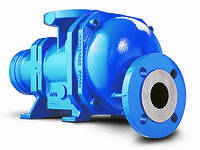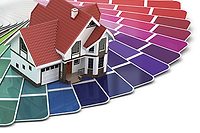New Binder for Weather- and Surface-Tolerant Wood Trim Paints

Paints designed for application to wood trim (wood used to cover transitions between surfaces or for decoration) represent a significant share of the market for wood coatings. Over the past decade, because of environmental and other legislation, there has been a general shift from solventborne to waterborne in most architectural and decorative coatings applications. The very feature that makes water-based coatings attractive from an environmental, toxicological and health point of view, i.e. that they contain water, is also the main reason for many of the problems that exist with waterborne technology, which has retarded the replacement of traditional solventborne paints. The latter continue to exist, and their use is still permitted despite VOC regulations and environmental labels, because it is widely recognized that no acceptable alternative exists at present. This is certainly the case of wood trim paints, especially those for exterior use.
Coatings for Wood
The keywords associated with modern wood coatings are: aesthetics, protection and functionality. Wood is a complex substrate, from both the physical and chemical point of view.¹ Wood “moves” as a result of absorption/desorption of water, so coatings must be resistant to external physical, chemical and biological influences in order to maintain long-term service life and to extend renovation cycles.
In brief, a coating system for wood must resist moisture, grain cracking and peeling, blistering and extractive stain bleeding, and UV light. For trim paints, ease of application, blocking resistance, gloss capability and leveling properties, as well as the ability to formulate at low VOC levels are additional requirements.
Tolerant Coatings
Surface tolerance is a well-known concept in the field of metal protective coatings,² but not so much for other substrates. One of the main features that such a coating should have is good adhesion to surfaces with less than ideal surface preparation. There could be many reasons why someone would want to apply a coating in less than ideal cleanliness conditions. For example, it might be very difficult or expensive to properly prepare the surface. With reference to wood coatings, surface tolerance is important in renovation, where surfaces may be coated with old layers of paint, or freshly sanded wood, where old paint has been removed.
Weather Tolerance (“All-Weather Paints”)
Most water-based coatings today are based on polymer dispersions, in which water serves as the dispersion medium and solvent. They dry by a process of coalescence. As such, it is important that the application, drying and coalescing conditions are controlled. Important parameters in this respect are temperature, relative humidity and ventilation.
For successful application, the consensus of most paint manufacturers is that the application window for water-based coatings in terms of relative humidity (RH) and temperature is relatively limited to RH between 40% and 60%, and to temperature between 50 °F and 104 °F. In practice, because the weather is often very unpredictable, and to extend the application window for exterior coatings to more than just a handful of ‘ideal’ days, the range is usually extended somewhat.
An extended application window (early rain, cold weather) allows for more convenience and more flexibility in application, saving time and providing better cost-in-use.
Polymer Design – Technical Approach
A review of the literature would suggest that the general consensus today among polymer development chemists is that multi-phase polymer particles with heterogeneous morphology is the best and perhaps only way today to achieve the conflicting requirements of hardness/blocking resistance/dirt pick-up and good film formation at low VOC levels with minimum use of coalescing solvents.³⁻⁶
Such multi-phase particles are produced by a procedure using at least two different monomer mixtures (usually with significantly different Tg) fed sequentially or partially in parallel to the polymerization reactor. Thermodynamic and kinetic factors during the emulsion polymerization reaction determine the morphology of the resulting polymer particles, and the benefit of the above procedure is that it creates structured polymer particles, in which the high Tg fraction provides hardness and blocking properties, while the low Tg fraction contributes to good film formation and flexibility.
The new polymer was designed using a heterogeneous, multi-phase acrylic emulsion polymerization process to enable the coexistence of hard and soft polymer phases. It is this duality, in conjunction with the pure acrylic composition, that allows it to overcome the paradoxical constraints of flexibility and hardness, together with the water and weather resistance properties necessary for binders for formulation of wood coatings.
To further enhance the properties, the development of the new binder leveraged more than a decade of experience acquired through our now well-established EBS technology, used in exterior masonry applications,⁷⁻⁸ which ensures excellent film formation in less than ideal drying conditions. Our aim was to translate that proven performance into more complex substrates like wood, and provide formulators with additional options to adapt to changing weather patterns.
New Binder
The new binder that has been developed and launched is a multi-phase-type pure acrylic, known commercially as Synthomer Hydro PLIOLITE® 330. The physical properties of this latex are summarized in Table 1.
The latex was tested in a sheen formulation, at approximately 23.5% PVC, as shown in Table 2.
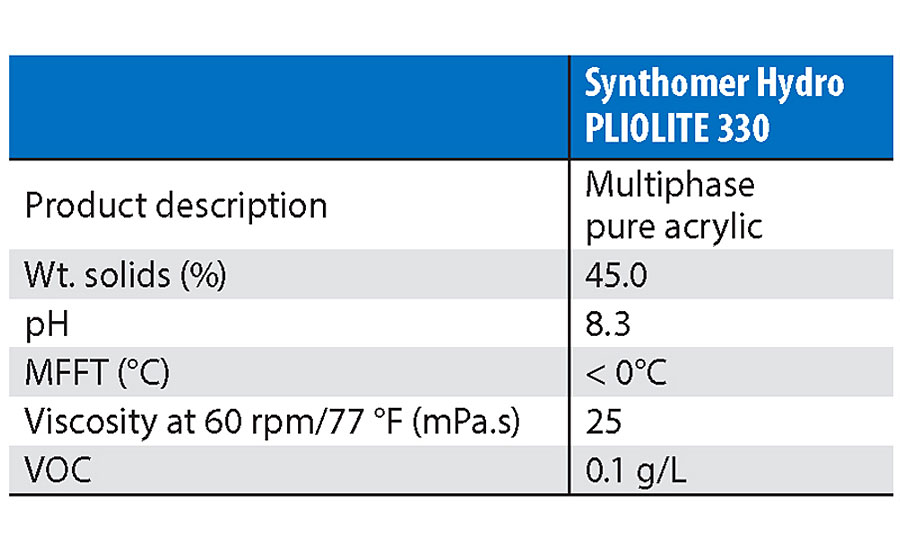

Experimental — Test Methods
In all the following tests, the experimental gloss paint formulated with Synthomer Hydro PLIOLITE 330 was compared with a number of commercial water-based and solvent-based paints of similar sheen level available in the European market. The characteristics of these commercial paints are summarized in the Table 3.
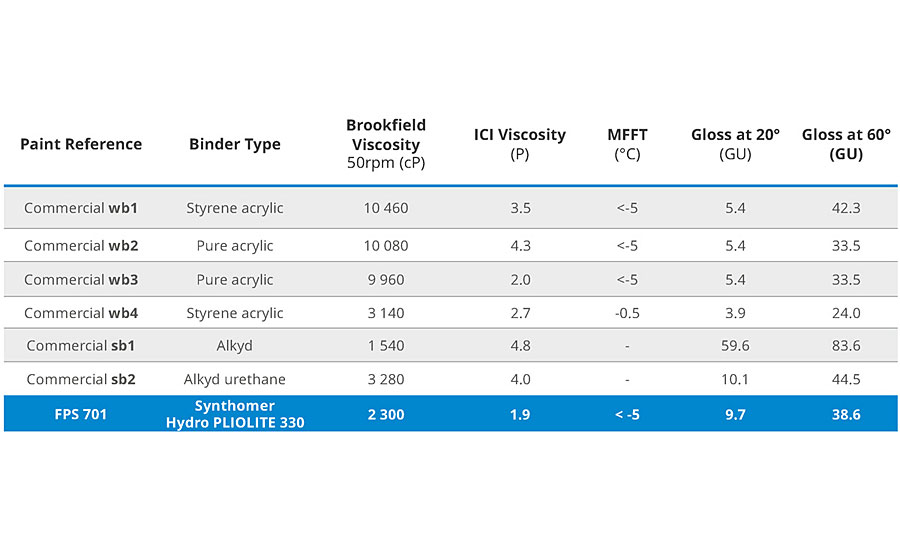
Grain Crack Resistance
Two coats of solvent-based alkyd paint were applied on half of a beech wood panel and dried at 122 °F for 5 days. Two coats of wood trim paint were applied by brush on all faces of the panel and dried for 24 hrs at 73 °F/50% RH. Panels were then submitted to 20 cycles of the following conditions: 4 hrs at room temperature, 3 hrs at 122 °F, 1 hr of immersion in water and 16 hrs at -4 °F. The variation in weight of the panel and the aspect of the film were noted after each cycle.
Blocking Resistance
A 6-mils wet paint layer was applied with a bird applicator to a black PVC Leneta panel. After drying the paint with a variation of drying times (1 day or 1 week) and drying conditions (73 °F/50% RH or 41 °F/ 90% RH), 2-cm strips were cut from the panels and then placed in direct contact with a pressure of 125 g/cm² during 24 hrs at 73 °F or 122 °F.
The blocking resistance of the paint was assessed when samples were pulled apart. Blocking resistance results are rated from 0 (bad) to 10 (excellent), and the percentage of removed paint was also reported. Results are the average of five trials.
Shower Test (Early Rain Resistance)
Two coats of a solvent-based alkyd paint were applied to a vertical half of the panel and dried for 5 days at 122 °F. The lower part of the panel was sanded (#180 grit finishing sandpaper). Before testing, the panel was stored 24 hrs at 41°F and 90% RH. One coat of wood trim paint was applied by brush at 130 g/m² and dried at 41°F/ 90% RH during the following times: 90 min/60 min/45 min. Then, the freshly painted panel was subjected for 3 min to a high-flow water shower (6 liter/min). The paints were assessed and rated visually (Figure 1).

Natural Weathering – Outdoor Exposure According to EN 927-3
Two coats of wood trim paint were applied at 130 g/m² by brush to the front face and sides of a fir wood panel. End grains were sealed with a high-solids, solvent-based alkyd paint. After 7 days of drying at 73 °F, initial L*,a*,b* and gloss were measured with a spectro-colorimeter. Then, panels were exposed at 45°, facing south for 12 months, in Villejust (Paris area), France.
Results and Discussion
Grain Crack Resistance
The objective of this test, with “heating-immersion-freeze-thaw” cycles, is to evaluate the ability of the coating to protect exterior wood prone to dimensional change under temperature and humidity fluctuations. The behavior of the film on half-painted panels (simulating limited surface preparation) can be checked as well.
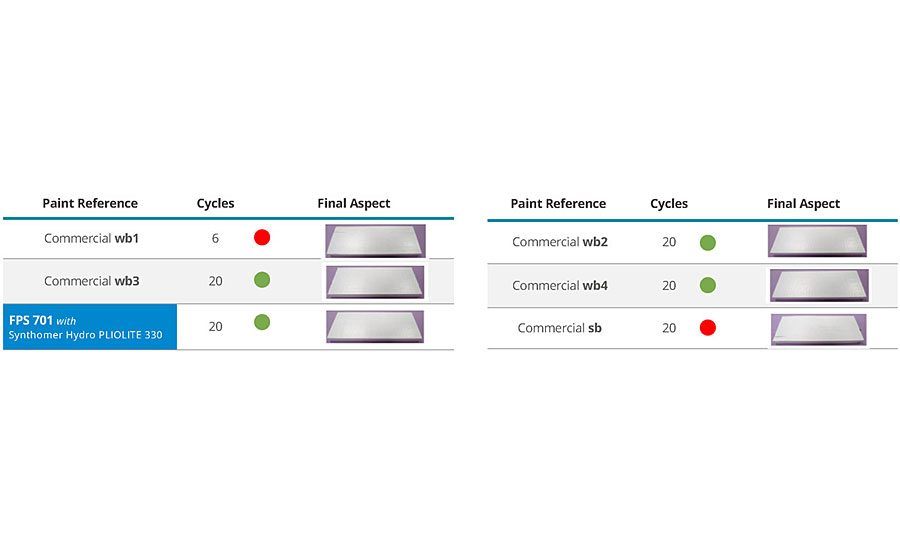
Commercial paint wb1 showed cracks after 6 cycles, which could indicate a lack of flexibility of the film that would negatively affect long-term durability. With the exception of the commercial sb2, failing after 20 cycles, all other formulations passed the crack resistance test, which indicates they have the expected flexibility and water resistance to support wood deformation under these critical aging conditions (Table 4).
Blocking Resistance
The objective is to evaluate the ability of the paint to resist blocking after drying, under “standard” and adverse drying conditions. Whereas blocking resistance at 122 °F is often highlighted as a “must have” by formulators, the blocking resistance after drying in cold and humid weather is obviously difficult to achieve.
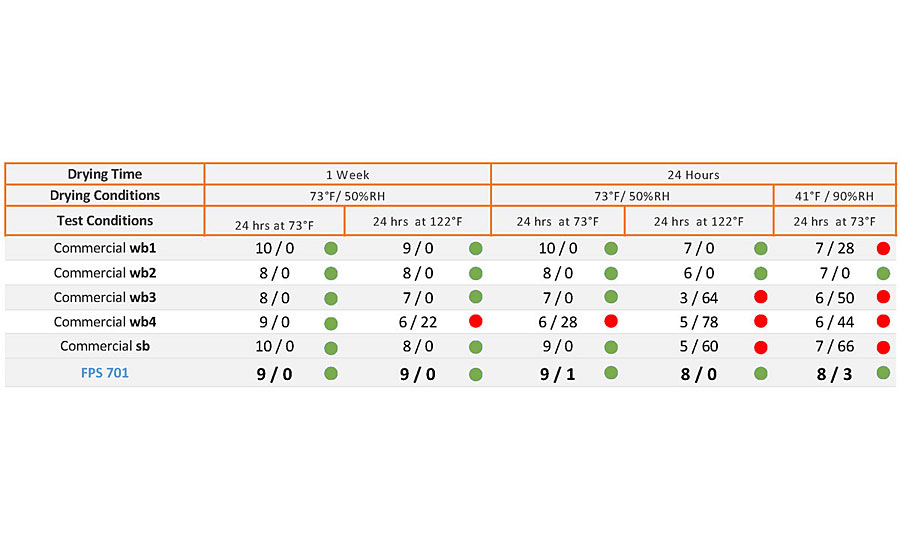
All formulations demonstrate good blocking resistance at 73 °F after 1 week of drying. Nevertheless, when drying time is reduced to 24 hrs, hot blocking resistance with most of the commercial products is difficult to obtain. As far as adverse climatic conditions are concerned, only the commercial wb2 and the experimental formulation FPS701 made with the Synthomer Hydro PLIOLITE 330 show very good blocking resistance (Table 5).
Shower Test (Early Rain Resistance)
The objective of this test is to evaluate the ability of the paint to dry under severe weather conditions (low temperature/high humidity) and to resist a shower of rain very shortly after application.
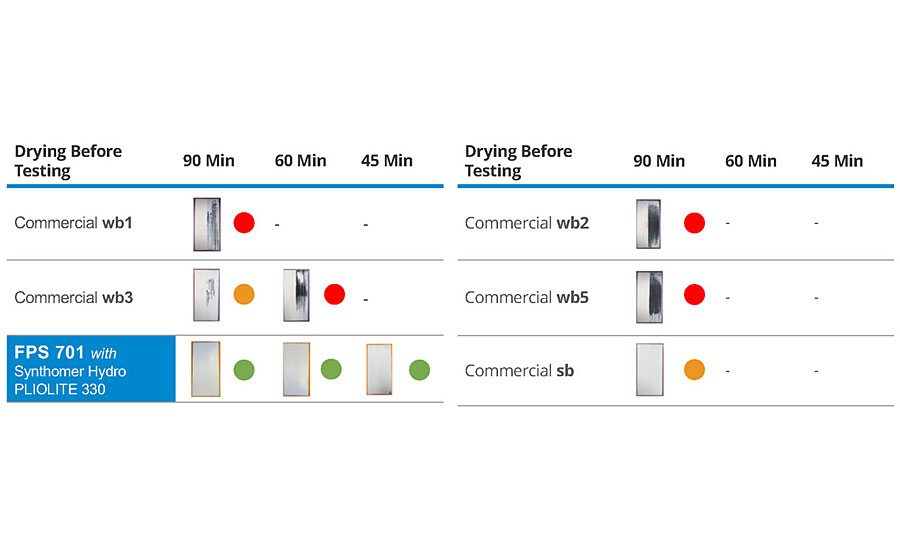
Even if the solventborne alkyd paint is not removed by the shower, this critical test shows that it is impacted by water during early stages of drying (Table 6). Beyond possible defects that can occur during oxidative drying, the commercial solvent-based paint exhibits visual defects due to water droplets that remain at the surface of the paint, as it can be seen in Figure 2.
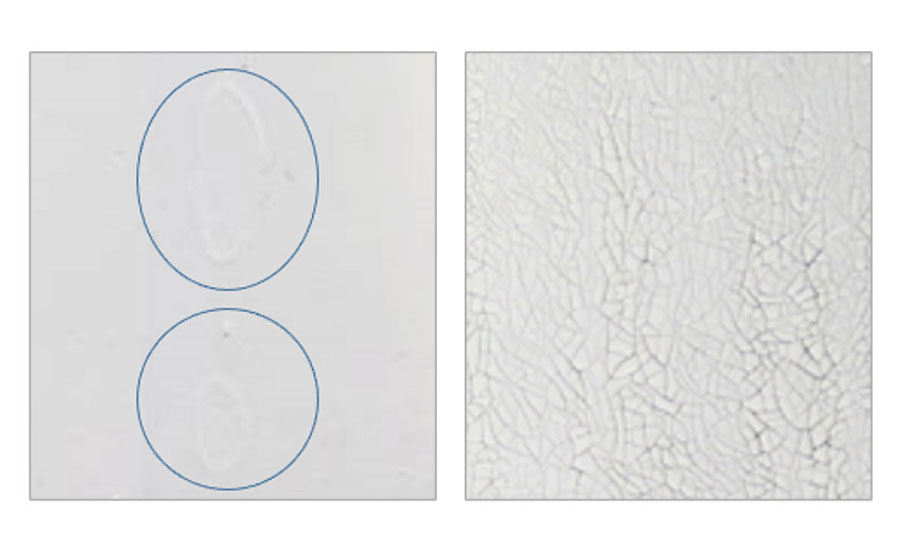
Regarding the commercial water-based paints, the shower damages them all, even after 90 min of drying at low temperature. Commercial wb3, which appears to have suffered less damage after testing, actually exhibits micro-cracking, indicating poor film formation. This is probably due to incomplete coalescence and rinsing of the paint film during the shower phase, leaving insufficient coalescent present within the paint to ensure good film formation when the water evaporates. Synthomer’s Hydro PLIOLITE 330 demonstrates superior early rain resistance compared to the commercial waterborne paints. When dried under critical cold and humid conditions, the FPS701 paint based on Synthomer Hydro PLIOLITE 330 gives performance close to that of the solventborne commercial paint.
Natural Weathering
Dirt pick-up resistance is another key attribute that needs to be balanced with flexibility of the film: natural weathering under outdoor exposure is the most relevant method to evaluate this property. Figure 3 shows the evolution of Delta E* (total color change) of the paint formulated with Synthomer Hydro PLIOLITE 330 (FPS701) compared to the commercial water-based and solvent-based paints.

With the exception of Comm. wb2, that shows a strong delta E* increase within the first 6 months, all paints demonstrate good outdoor durability as far as color retention, dirt pick-up and resistance to cracking are concerned. The Synthomer Hydro PLIOLITE 330 paint formulation FPS701 demonstrates very good durability, as no defects other than a slight dirt pick-up can be seen (Figure 3).
Conclusion
A new binder for water-based wood trim paints has been designed based on a heterogeneous acrylic polymer structure. It combines excellent flexibility and high blocking resistance, while maintaining low VOC content in line with most stringent requirements.
In addition, leveraging many years of experience gained with a proprietary EBS technology platform, additional features of weather and surface tolerance have successfully been incorporated.
Innovative test methods have been developed to demonstrate the benefit of this technology: compared to conventional waterborne wood trim paints, early rain and blocking resistance are significantly improved when the film dries under low temperature and high relative humidity conditions.
The excellent adhesion properties (old alkyds, bare wood), flexibility and weatherabilty of the binder provide long-term protection on wood substrates.The new Synthomer Hydro PLIOLITE 330 binder minimizes many of the common problems associated with the application of water-based wood trim paints, in particular problems linked to weather conditions during the application and drying phase, and to surface preparation.
This technology provides a new level of performance in “All-Weather” water-based paint.
References
¹ Sponsel, K.; Wallenfang, W.O.; Waldau, I. Lexikon der Anstrichtechnik 1 – Grundlagen, 2 – Anwendung, Verlag, Callwey, Munchen 1992.
² Mitchell, M. High Performance Surface Tolerant Coatings: A Review, Conference paper, NACE, Corrosion 2003, 16-20 March, San Diego, California.
³ Schuler, B.; Baumstark, R. et al. Structure and Properties of Multiphase Particles and their Impact on the Performance of Architectural Coatings, Progress in Organic Coatings, 40(1):139-150, Dec 2000.
⁴ Stubbs, J.M.; Sundberg, D.C.; The Dynamics of Morphology Development in Multiphase Latex Particles. Prog. Org. Coat., 61 156-165 (2008).
⁵ Bernhofer, T. Novel Multiphase Acrylics for Joinery Coatings, European Coatings Show (ECS) 2015.
⁶ Perez-Lorenzo, G. New Synthesis Technologies and Composition Design for a New Generation of Heterogeneous Polymers, Farg och Lack, Vol. 73, Nr.1, pp 10-17, March 2018.
⁷ Baude, C.; Sécher, M.; Fream, A.; Bousseau, E.; Barette, A. New Waterborne Binder for Masonry Primer, Eurocoat Congress, Paris, 2018.
⁸ Duval, F.; Fream, A. Exterior Masonry Coatings in Europe, Pitture e Vernici, Vol. 80 (2), 2004, pp 30-37.
Looking for a reprint of this article?
From high-res PDFs to custom plaques, order your copy today!




